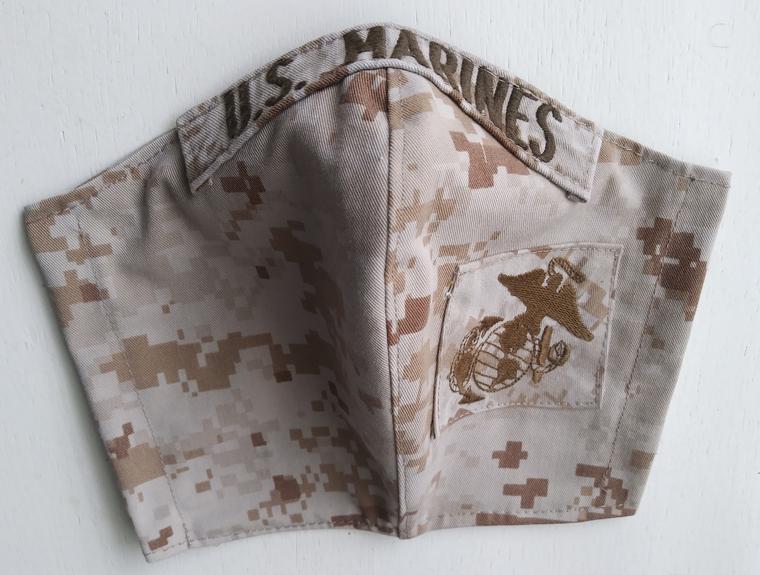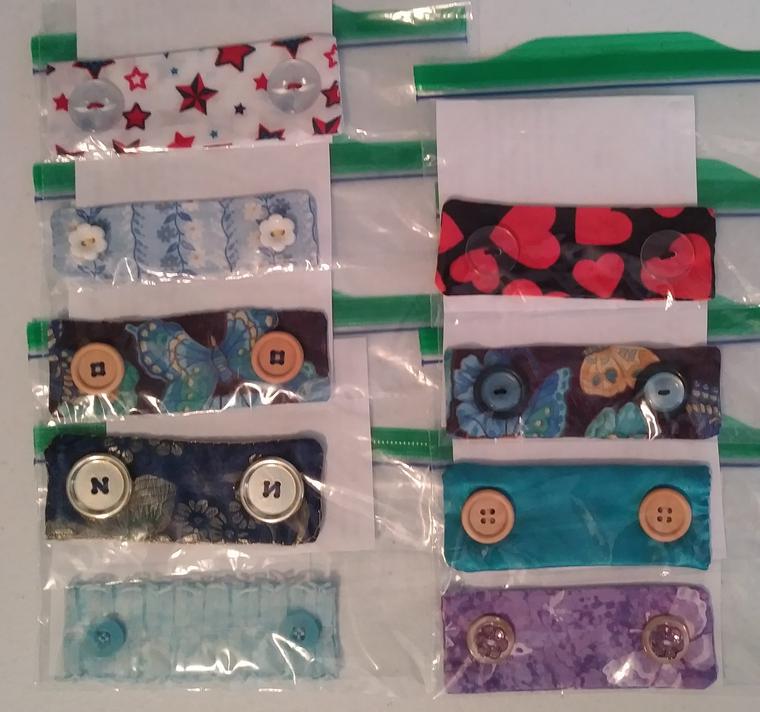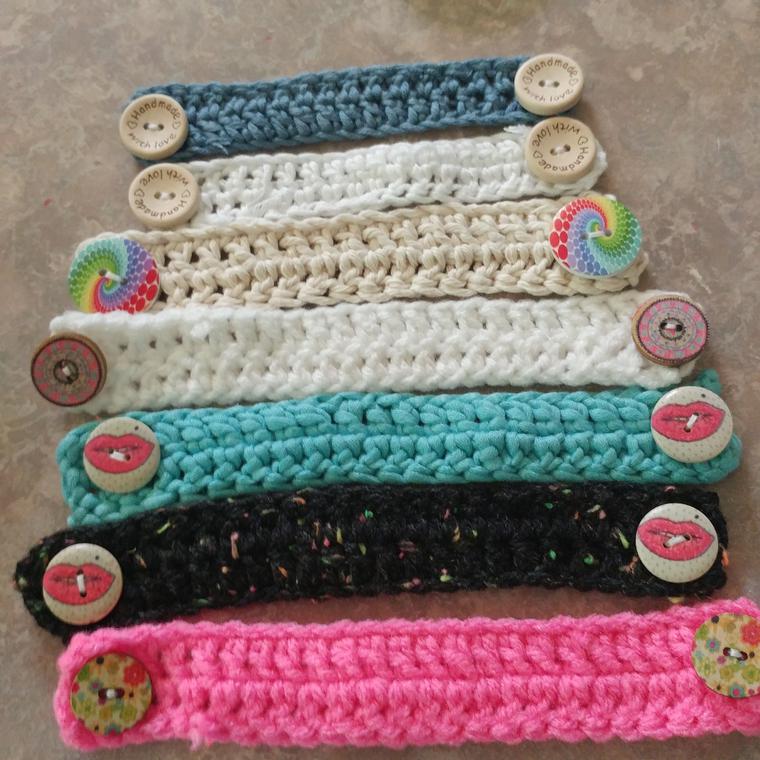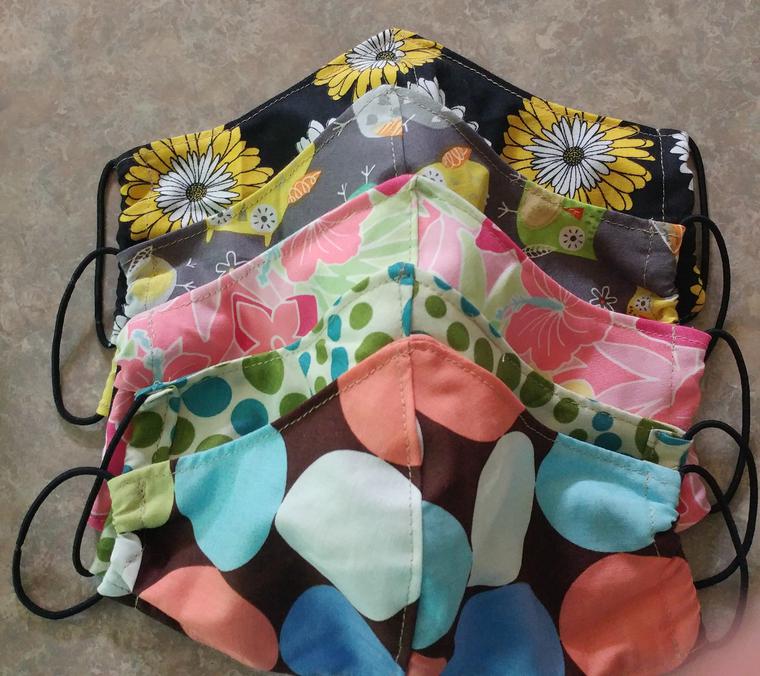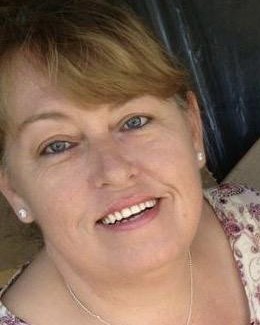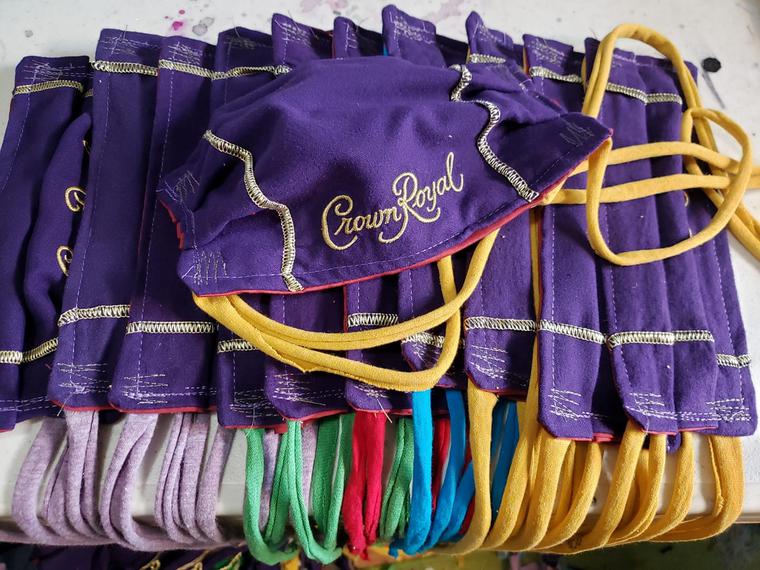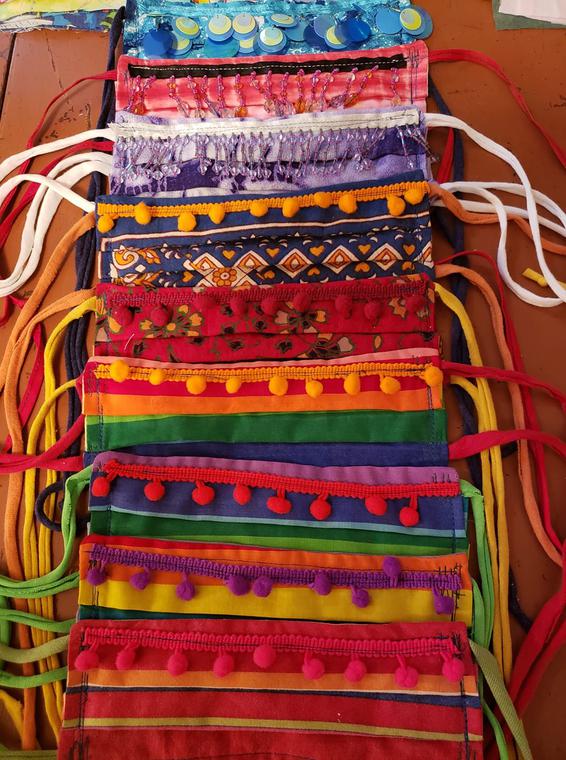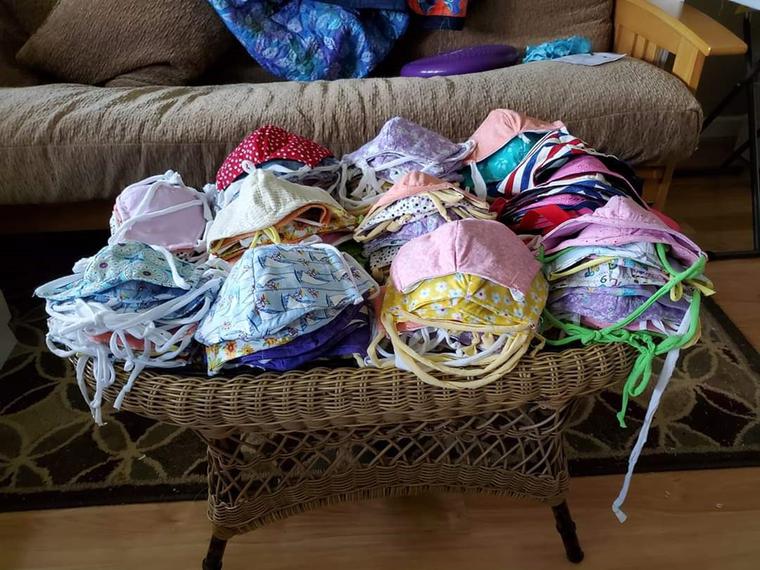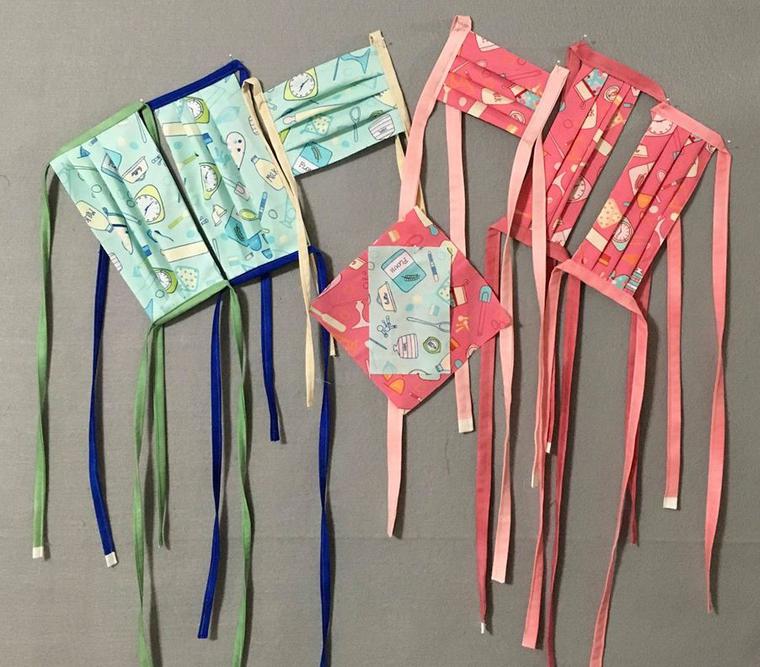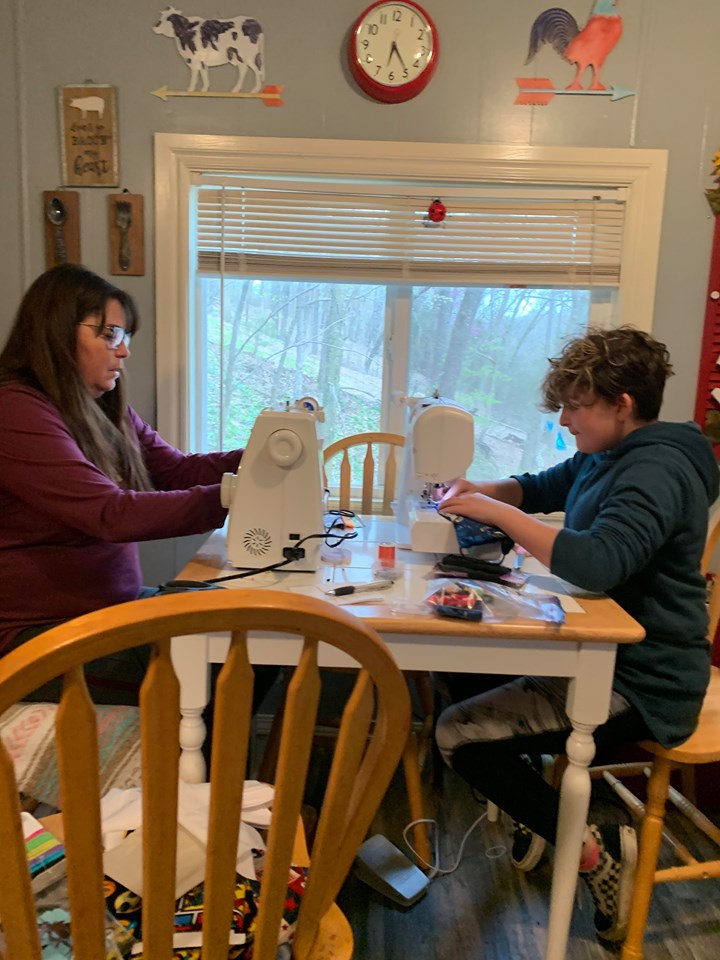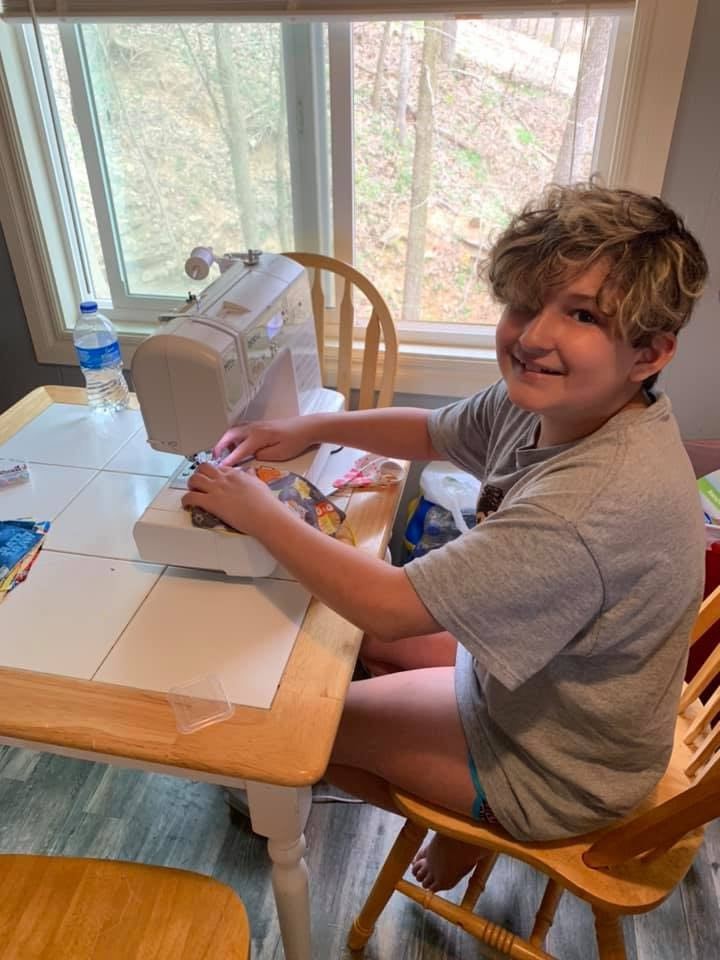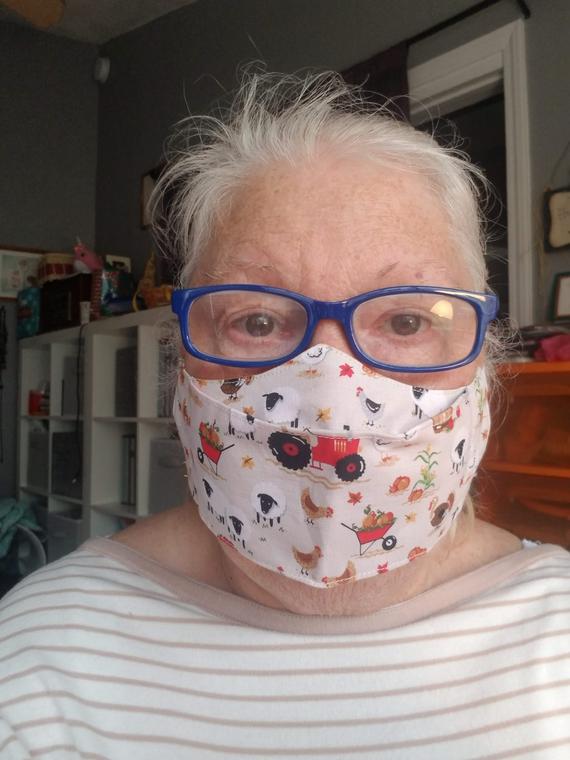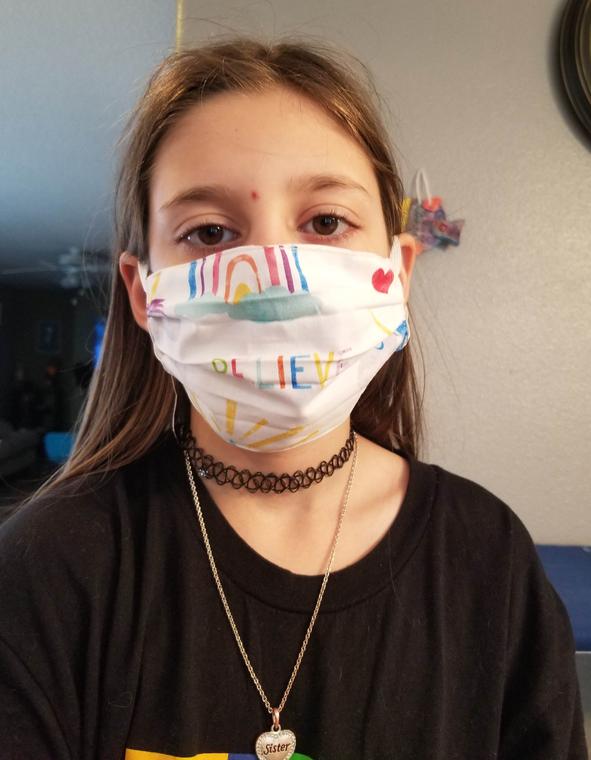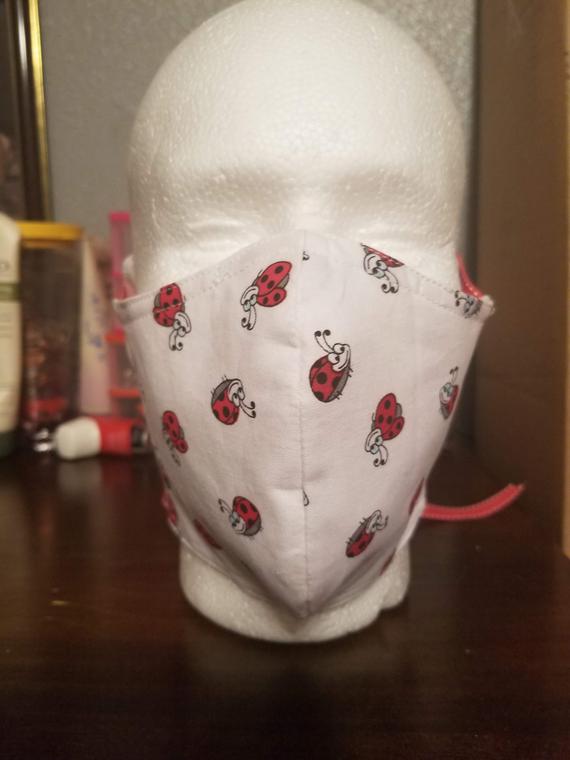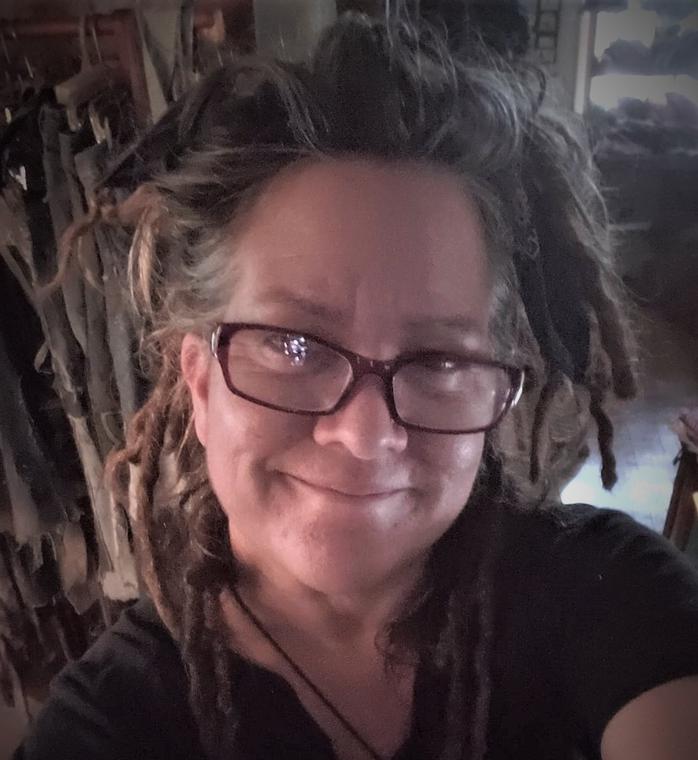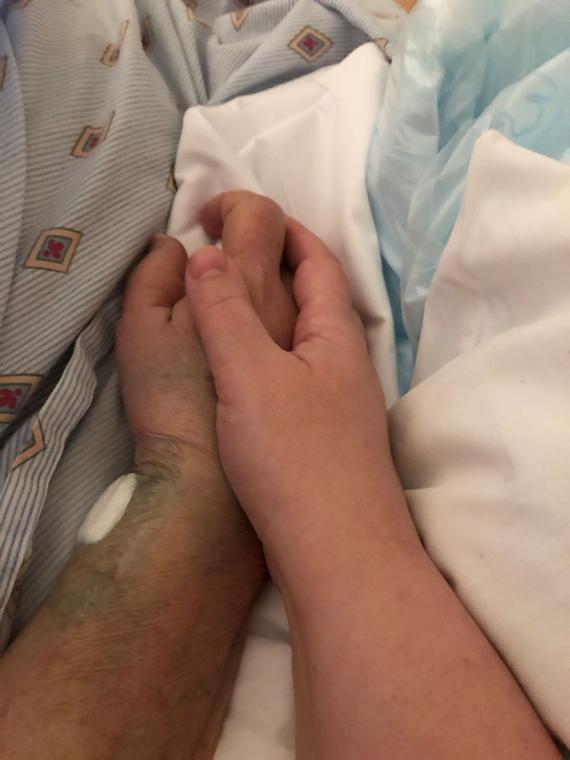Non-Fiction - Memoir
DEDICATION
This book is a tribute to all the mask makers of the 2020 pandemic.
I would like to extend a special thanks to the mask makers who submitted their stories as selflessly as they pledged their labor and materials to supply masks in a time of desperate need. Their stories often put a lump in my throat.
I would also like to thank my editors: Sandra Garrett, Helen Sienerth and Anita Goolsby. All have donated hours of editing, accepting only the opportunity to read my books as payment.
The world is full of selfless people who are rarely celebrated.
Linda L. Rigsbee
****
INTRODUCTION
No doubt, the year 2020 will go down in history as the year of the Covid-19 Pandemic. Officially, the first confirmed case of SARS-CoV02 was documented in Wuhan City, China in December of 2019. The first confirmed case of Covid-19 in the USA was documented in the state of Washington on January 20, 2020. That person had been a passenger on a flight from Wuhan, China.
While The World Health Organization (WHO) declared a public health emergency due to Covid-19 on January 31st, it wasn't until March 11 that they declared it a Pandemic.
Between March 19 and April 7, beginning with California, states began lockdowns. By April 3rd, the CDC began recommending the wearing of face Masks as a method of controlling the spread. Between April 8 and May 15, governors of 15 states were making mask mandates.
The USA went into a lockdown, closing schools and business in an attempt to slow the spread and thereby assure hospitals were not swamped with patients all at once. Hospitals needed time to obtain necessary equipment, such as respirators, masks, gloves and other supplies required to treat patients. Since most of these supplies were being reserved for front-line workers, a shortage was created for the general public.
Global and local statistics on new cases and deaths dominated the news, while strange items became scarce. A shortage of toilet paper may have been the first indication that all was not well with commerce. Store shelves emptied as non-essential businesses closed their doors for an undetermined period of time. Hundreds of thousands of people were laid off work and the economy staggered. Wall Street responded with plunging stock prices. Those whose jobs were determined to be essential worked harder to fill the shoes of those who were not.
The extent of lockdown was determined by state government, but rules made for conditions in the larger cities extended to the rural areas where they were considered unnecessary disruptions of everyday life. Some people panicked and conspiracy theories ran rampant. As weeks ran into months and the possibility of a great depression loomed, protestors took to the streets. They wanted to go back to work. Store shelves became bare and their hours of operation shrank. Government responded with provisions so people would not be evicted because they couldn't pay rent. The issuance of unemployment checks on such a mass level took time to initiate, as did a massive stimulus package. New phrases came into existence – "The new normal" and "Social distancing."
Amid the sickness, death and panic, many people remained calm and did what they could to help others. The country quickly depleted their stockpile of masks. With industries failing to meet the need, private citizens dusted off their sewing machines and began making washable cloth masks. Most people had neither the skill nor the equipment to sew, so the responsibility fell to those who could.
Many mask makers worked long hours at their sewing machines without thought of monetary compensation. They dug into their supplies of remnant thread and fabric. People donated material. Elastic became so difficult to find that substitutes like T-shirt material were used to keep masks on faces. In the beginning, hospitals dictated mask design, but as the need for masks shifted to the general public, different patterns were developed to meet more specific needs.
In hospitals, masks were most often used to protect both medical personnel and patients. Requirements for the general public were primarily to protect other people.
In the following pages, mask makers tell their story of what inspired them and what kept them going. Their sacrifices and labors are documented for future generations. These are some of the people who quietly made a difference during the 2020 pandemic.
****
Fayetteville, Arkansas
I worked in an office most of my life – 30 years with one company. When I lost my job due to downsizing, I worked several jobs before finding a job I loved. I became a professional caregiver. As it turned out, it was good training. I retired at 62 to be a caregiver for my husband, who had been paralyzed during a heart catheterization. (I wrote a book about that; "Another Mountain.") Fate deals us some mountainous challenges and we have no choice but to work our way through them. I am now an active 71-year-old who sees the world from a different perspective. Perhaps that is part of what inspired me to become a mask maker during the 2020 pandemic.
As a published writer, I saw a story about mask makers that I thought needed to be told. Who better to write it than a writer who had actually participated in making masks? I contacted other mask makers to get their input and then started this book.
When I was about eight years old, my mother gave me a needle, some thread and some material to make clothes for my doll. I've been sewing ever since. Under Mom's tutelage, I learned more than I would have in home economics. My mother made all our clothes, and like so many other things, she did it with proficiency. I have made clothes for my husband, my children and me, as well as sewing for many other projects.
When the 2020 Pandemic started, masks were in short supply. Available masks were, understandably, being prioritized for front line workers. I had fabric scraps, equipment and sewing skills that many people didn't. I felt a civic obligation to help. Many people were making masks for the hospitals, but I decided to concentrate on the general public where masks were unavailable. I was a member of the Elkins Farmer's Market, where I normally sold my books. Marketers were restricted to essential items only, and books were not considered essential - masks were.
While many people were making masks and giving them to hospitals free, I was charging the public. I never completely forgave myself for that. I did give many masks away free, but my logic at the time was that if I gave out free masks, some people might be reselling them. I couldn't control the price someone else charged, but I could control the price I charged, so I tried to keep it as low as possible. I thought about the cost of the material, my labor, wear and tear on the equipment and the cost of marketing them (bags to put them in, gas to go to the market, as well as the time taken from my family.
I printed the free Aries 2.0 Face Mask pattern from an internet site. It had a pocket for the N95 filter and different ways to attach it to the face. It was comfortable, so I stuck with that throughout the months of mask making. At first, it took me about a half hour to make each mask. I've been accused of being a perfectionist, but I think maybe I'm just slow. I sold my masks for $4, which was cheaper than washable masks could be purchased elsewhere. Later, when I had to start buying fabric, I discovered that fabric was a little like toilet paper – difficult to find and expensive when I did. I raised my price to $5 – still cheaper than they could be purchased anywhere else at the time. I wasn't making much profit on each mask, but I was selling them faster than I could make them. I would open my booth and sell almost all the masks inside of an hour. I had people standing in line – often waiting in their cars when I got there. I often got up at six in the morning and began making masks. I would stop long enough to rest my aching back and cook meals – then back at it until ten or eleven at night. I was exhausted and wanted to quit, but there was such a need that I didn't feel I could. I thought about all the people making masks free, and shamed myself into continuing.
I did make enough money to get my old Singer sewing machine repaired. I had purchased that machine in 1970 to make baby clothes for our first son. It now sits in a sewing cabinet my father made for me in my office – beside the desk where I am writing this book. I gave the newer sewing machine to my younger sister.
Finally, my older sister made sixty masks and sent them to me so I could take a day or so off. She had been making them for hospitals – for free. I insisted on sharing the profits with her because she didn't want to take the money. This is so typical of many mask makers; dedicated, selfless and, for the most part, unrecognized. This is why I decided to write this book and dedicate it to the Mask Makers of the 2020 Pandemic.
Eventually, we got another Mask Maker at the market and I had some time for other projects that had been set aside. At publication of this book, I have made about 500 masks and mask mates for men, women and children.
The demand in my area for my masks has dried up, as there are affordable masks available at all the stores now. In my search for contributors to this book, I discovered a Facebook group where these masks are still needed, so I am boxing up the rest of my masks and donating them to this group. I made a dozen Christmas masks for my family and to give away, but I probably won't be making any more unless by special request. I have made special requests before and will continue to do so as long as there is a need.
My home state, Arkansas, received its first shipment of Covid-19 vaccine on December 14th, so I hope this pandemic will soon be over.
The wearing of masks became a political hot issue for some, and there has been some belittling. Hopefully, we have grown accustomed to seeing them by now. I have been wearing masks for years in the spring, due to allergies. I hope the availability and familiarity of wearing masks continues in future flu seasons and we can whip out a mask without people staring at us as though we might contaminate them.
NOTICE:
No membership or information is required to read this book free online.
It is a violation of copyright to use all or part of this book without written permission from the authors:
Linda Rigsbee, Sandra Sienerth, Jeanie Scott, Apryl McAnerney, Erin Lale, Roxanne Fiant Walker, Sarah Mayes, Barbara Troeger, Judith Cigich, Teresa Presley, Virginia Schrenker, Wanda Ehman, Lynda McCarty, Summer Pearl Browning, Toni Nelson, Paula Bray, Sam Sauter, LaVerne Bartley, Lisa Masog and Anonymous.
Mask Makers of the
2020 Pandemic
by Linda L. Rigsbee
Archdale, North Carolina
I am currently staying at home on disability. I had worked many years as a seamstress for a local upholstery shop but I’ve been unable to work for more than 3 years, due to major surgery, which left me diabetic as well as having several other related medical problems.
Not long after the surgery, I started helping my son raise my two youngest grandkids who are now 12 and 5: quite a handful at that age. Then schools were closed, due to the outbreak of covid-19, and I helped them schedule their school work via video classes. (All I can say on that is that teachers should be paid a lot more for the work that they do).
My son works at Walmart. He came home one night after work and told me his manager asked him if he knew anyone who sewed and he told them that was my job before I was unable to work. My son's manager wanted masks made for his employees because there was a serious shortage of available masks due to so many companies and medical facilities requiring everyone wear masks before they entered the establishment.
I had a professional sewing machine in my home and had often worked various crafts and quilting so there was an abundance of fabric stored in my sewing room. I began sewing that night and actually finished 30 masks for my son to take to work the next day. Then, I began researching online for patterns that could be adjusted for kid-sized masks. Started sewing those and posted availability on Facebook. Very soon family and friends were requesting masks. At first, I gave away many, but many were appreciative of my work and insisted on paying for those they received. I was not charging as much as others who were making masks for sale. I charged only $2.50 for masks and $1 for extenders that I crocheted and sewed buttons on to attach to the ear pieces of each mask to stretch behind the head for less stress on the ears. I’ve currently sewn 100 to 150 masks but will continue to sew more to keep on hand should the need for more arise. I will donate to people and places that can use them.
I am unable to sit at the sewing machine for long periods of time, but I do what I can. Fabric is getting scarce and I’ve appreciated receiving miscellaneous yardage from others. Elastic for earpieces also in short supply, so I began to use hair bands instead – which seem to work fine.
I have always liked to help others and it just makes me feel better to help where I can.
Postscript: After complications from additional surgeries, Sandra passed away on August 16, 2020. RIP
Kansas City, Kansas
I saw a friend on Facebook mention that she could use some help making masks. She provided me with material already surged together and the elastic to use. I sewed the elastic on and created the pleats. I only sewed approximately 150 masks. Most of the masks I made went back for her to distribute but I was able to keep some. I provided masks for my husband, all of his coworkers, and some of their families as well. I kept a dozen which I give away as I come across people without one. For instance; the last one I gave away was to the cashier at my local grocery store.
I spent approximately 5 minutes per mask. I am not a seamstress by any means but like I told my friend, "I can sew on some elastic." I never learned to sew properly. I cannot read a pattern from the store.
Kansas City, Missouri
I’m sure I’m not alone in feeling a need to tell a story about this pandemic and how it has affected me, especially as a mask-maker. There is perhaps an even deeper feeling of isolation and anxiety, being chained to a sewing machine and feeling the terrible sense of urgency to protect people, but with such gratitude to be able to do something.
I started making masks on March 21st, 2020. That day I received 3 videos on the process from friends on Facebook, knowing I sewed, wanting some for themselves. I had amassed a vast collection of material over the past 4 years since I learned to use a sewing machine. All of my jobs and volunteer opportunities vanished a couple days prior, but I had no idea they would not be returning to me for so long. As a professional artist for over 30 years and a gallerist for 7, learning to sew was just a new art form I was eager to learn. I began upcycling clothes, drawing and painting on them, creating new forms, turning jeans into skirts, adding material to make favorite clothes that were too small now fit me and friends again. It was not terribly lucrative but extremely exciting because I was making art that walked around in the world instead of hanging on walls and made people feel pretty. My main source of income was house painting, faux finishing and murals, but when this pandemic hit, no one, nor I, wanted to be in anyone’s home. I chose a simple tutorial for masks from the Deaconess Hospital website, CDC approved, rectangular accordion-fold, doubled up cotton fabric and elastic ear loops. Friends sent me elastic but, as many people began making masks, the world quickly ran out of elastic to purchase. Some people found it uncomfortable anyway, so I switched to using bias tape for a while. I have moved on to making T-shirt yarn strips that go around the head. They are softer and more easily adjustable, and very colorful! Although there are many styles I could make, this one doesn’t require a filter pocket, nose wire or a pattern, so I can make 10 a day. My goal has been just to protect people as they attempt to navigate this “new normal”, and until they can or choose to purchase a fancier and more protective version elsewhere.
Today is May 13th and I have quite literally done little else than make masks every single day, except for exactly 3, since March 21st. My house and yard are a mess. The usual Spring transition of plants from inside to outside and fluffing of porches has come and gone in a half-hearted way. Normally I too transition to the outside with my plants and prepare for parties, cook outs, gatherings, knowing that all my cleaning will result in a much larger mess after the party but not caring. Normally I would relish having muddy knees and hands from repotting and planting, raking, bagging the winter debris, breaking up and collecting sticks and firewood. Normally I would be making pretty summer clothes, inviting people in to try things on, take measurements, discuss their fun wants and needs in upcycling their clothes or my current clothing obsessions. I’d planned to work on swimsuits this year, being older and wider myself now and unhappy with the styles available and the high prices. I had an exciting plan to project images onto shirts and dresses, sketching them out to wrap around the clothes on the dress dummy using fabric pens and paint! And normally I’d have several house painting gigs coming up to pay my bills. I’d had a couple of wonderful and very fulfilling volunteer opportunities that might become paying jobs too.
But Spring is quickly moving along without me. It looks like a thrift store exploded in my house as people keep bringing me clothes and fabric to use for masks. I’ve taken over three of the four bedrooms in my house to produce masks and rearranged everything for most efficient production. Every morning I think that maybe today I will take a break from making masks and do something else, but then there are new orders, and I’m back at my sewing machine, listening to a book on tape, looking at the outside world through my window. I have to write “Shower! Eat!” on a sticky note to remember to do so. I have massive anxiety over leaving my house for any reason but also enjoy a brief thrill at being OUT. Very similar to being a kid on a roller coaster, it's terrifying and fun and I can't wait to get off the ride, back safe at my home and in my studio.
I could complain, I do complain some, but really have no reason to. Essentially, I am doing what I love, making things and being useful, wearing comfy clothes all day, every day, and I have a sense of purpose, a reason to get up every morning, and for that alone I am so grateful. In many ways my life hasn’t changed much but become better than it was before, and that’s a very conflicted feeling, to benefit from such difficult and scary times. I think it’s the contrast that I appreciate now and miss. When you have to get out in the world more often, get dressed and ready to interact with people, you relish the days that you don’t have to do such things and might make better use of that time, or just relax and nap thru the day with perfect ease because you feel you deserve it. I don’t have any days off anymore without a struggle or pure exhaustion. I make masks in my sleep and dream of making them during the 4-6 hours a night I might actually sleep and dream. It’s also become my only source of income. Donation-based, they are essentially free to anyone in need. I don’t feel right about denying anyone or charging much, nor can I comfortably make anything fancier that might take more time and cost more when people are having to go back to work out in the world now. It's too hard to justify taking the time to enjoy and explore more creative designs and art making, though I wish I could. How can I look forward to doing so? It means that wearing masks is Normal, the new office tie or fun socks. It means that this pandemic is here to stay when all I really wanna do is see my friends and family, hug them, curl up in their laps and lick their faces like a puppy.
Thank you, Linda. I needed this outlet. I appreciate you!
Apryl McAnerney
LYF3 Upcycled Clothing on FaceBook
Henderson, Nevada
So far, I've only made 4 masks; 2 for me and 1 each for my brother and his partner. I plan to make more, though, and I've given away about 20 lbs. of fabric from my stash to different local friends who were making masks and ran out of fabric.
I got the pattern off the CDC website. The first one took me an hour, lol, but that was before I had a pattern. The fourth one took about 15 minutes. The limiting factor for me is the ties. I made the first one with shoelaces and the other 3 with ribbons that had come home from Renaissance Fair in my hair braids in various years. I'm running out of things to make ties with.
Postscript
I wrote the above in the spring. In September my companion, Tom, died of Covid.
Toronto, Kansas
I started making masks with help from my husband for the covid-19 pandemic. I started by making them for my family. My husband is not healthy and has been on oxygen for 20 years. I tried the surgical masks with the 3 pleats and hated them. Then went on line and found the Olson Medical mask, which was designed for their workers if they were needed. I liked it. Then got a kid's mask pattern from my cousin and designed it similar to the Olson one. I just did not have a child in my place to fit to the ears so I had to guess and made elastic with buttons to make sure it would work.
My first 100 masks ended up going to a nursing home that had an outbreak of Covid. I had a friend that did the research that the CDC had approved these filters - Merv 10 and up furnace filters. Okay so I got filters and put them in the slit area of the masks. So it would be more protective for the workers, I would make several and text a worker that lived in our town. I would hang the bag of masks on my ramp rail and she would pick them up on her way to work. The first 250 masks were made from my quilting stash. I did not think I would be making many more and I gave a big tub of fabric to a girl who was hiring some people to make masks. So, my supply was down I and had to get fabric at a store. I called and asked her if she would do curbside cutting, she did and she gave me a 15 percent discount. It was nice of her.
I gave my masks away to essential workers but others that called me; I told them I had about $3.00 in them and asked if they could pay that so I could get more supplies. Most gave me $5.00 or more. I even had people that would just send me money or give me supplies. Ponytail holders, pipe cleaners for the nose area. I gave those people a mask or more than 1. I gave masks to 2 other nursing homes. To Dodge City, KS where there was an outbreak and our Church. St Francis Hospital in Wichita. My sister would meet me in El Dorado, KS in a parking lot. We would visit sitting in our cars. I would give her the bags of masks and she would deliver them to the people in Wichita. I have also mailed masks to Missouri, Michigan, Arizona, Wichita and other places. I have several made up and now carry them with me and I give them to people who need them. I had some people ask to buy them.
When I started making the masks, it took 20-25 minutes from beginning to end. Now I cut about 40 or more, then sew everything. I can turn about 30-40 in 2 days if I work 7-8 hours a day. I have slowed down now as I have not heard of a place that needs them.
I can tell you this has made me feel like I helped. I could not be on the front line but I can help protect them.
My husband would cut the filters, help turn the masks, and insert the filters.
Elkins, Arkansas
Before the Pandemic, I was working full time and taking care of my family. When everything started closing and when things started getting really bad and masks became a requirement, I knew that I had a calling. As a mom of 2 very high-risk children, I knew masks were critical for my family. I went from working full time to working part time because of the pandemic, so I would spend the rest of my day raising 5 kids and making masks.
I found my pattern on the internet. I made masks for children as young as 2 years of age. As a mom of a 3-year-old with a lung disease, I wanted to make sure that even the smallest of children would be protected.
As the pandemic became worse and the numbers began to climb, I was cut from fulltime to part time at my job and that is when my family began to struggle. With every passing day I didn't know if we were going to be able to keep a roof over my children's head and that is when the profit from making masks saved my family. I still to this day make masks to help protect my family.
I have made over 300 masks. I have shipped and met people to distribute them.
Cobblestone Quilt Guild Community Outreach
Charleston, South Carolina
Article at https://www.cobblestonequilters.com
I am the Community Outreach Chairperson for the Cobblestone Quilt Guild in Charleston, SC. I wrote the following article about what our Guild members have been doing to help serve our local community and others.
Mask Making
Late one night, as I was surfing Facebook, I came upon an article on a shortage of N95 masks for medical staff. So, I did some research and found that crafters and seamstresses were making cloth masks in Georgia for the Deaconess Health System. Well, what do quilters like to do? Sew, of course! And what is never in short supply? Yes, stashes upon stashes of fabric.
I put two and two together and hatched an idea of sewing cloth masks for our local area of Charleston, South Carolina. Sure enough, as I reached out to local hospitals and institutions, there was a need in our area and some facilities were thrilled to accept them. Being the Community Outreach Chairperson, I quickly posted a video on making approved masks from the Deaconess Health System on the Cobblestone Quilt Guild Facebook page and sought members’ help. This was mid-March, 2020.
Naturally, the members of the Guild were ready and willing to provide cloth masks for Charleston and the surrounding area. In fact, some members were already making masks and providing them to family and friends. So begins the tale:
Being sequestered in our homes, a sewing project is just what we quilters needed. We all felt helpless during this crisis and wanted to feel that we were doing OUR part to keep everyone safe. We started our mass production from our own homes (to practice social distancing) and set up drop off points for the completed masks. Drop off, pick up, and distribution was coordinated with guild volunteers according to local areas.
Members were posting more and more videos on different ways to make masks…new and improved methods not just using elastic, but t-shirt ties and fabric ties; masks with openings for filters and insertion of wire or pipe cleaners to fit more tightly around the nose. Wow, the whole process was evolving!
As word spread, organizations began contacting our Guild and we rallied to the call. To date, over 5,000 masks have been made and donated to various organizations…local hospitals, dental and medical clinics, assisted living and nursing homes, first responders, agencies dealing with the homeless, the VA hospital and its satellite clinics. Some members also have shipped to facilities outside of South Carolina as well as family and friends elsewhere. Needless to say, we will continue to make masks until the need diminishes.
What can I say about this Guild and its members? I am humbled by these ladies’ generosity, kindness, selflessness and ingenuity.
Community Outreach’s motto is Busy Hands are Happy Hearts! Judging by the outpouring of their response, these ladies’ hearts are bursting with happiness and joy.
Near Bonner Springs, Kansas
A group of ladies from our church (Open Door Baptist Church, KCK), started making masks and I asked if I could also get involved. We had SO many people donating fabric and elastic. It has been amazing! I have made over 300 masks so far and have mailed them all over. Arkansas, Arizona, Texas, Wisconsin plus all over the immediate area. I donated some to the KU Cancer Centers also.
I watched several YouTube videos and then kind of came up with my own pattern! My job was outsourced beginning January 2nd and I have not gone back to work yet, so this gave me something to do (other than cleaning!) I have not charged anything for the masks, since the materials were donated, but several people have insisted on giving me money that I have donated to our church. I have been so blessed to be able to help in this small way. I never knew how good helping others could make me feel!
Pineville, Missouri
I'm disabled and get bored sitting at home all the time. Making masks gave me something to do – plus, I could help people. It took me about ten minutes to make each mask after I cut all the material. I got the patterns from Facebook, when they first came out. I got the material from Walmart and some donated to me. After I finished the masks, I'd starch them and put them in baggies. Then I'd meet the customer wherever they wanted.
I made about 1000 masks. I sold some and donated some to the doctor offices. When I knew it was a nurse placing an order, I told them it was free and thanks for the good work.
Sometimes I'd start making a mask and get halfway through before I noticed I'd forgotten to put the elastic in it – or start sewing and noticed I didn’t have it the right way. Then I'd have to start all over. It’s easy work but sometimes you just make mistakes. LOL.
At one point, I got so far behind that I asked my 10-year-old granddaughter, Jayden Mills, to help me sew masks. She had fought and won a battle with cancer. I taught her how to sew masks. She would make five masks and say I owed her $25. I'd pay her right then. She did that until she made $100. I had to stop because she was breaking me but without her, I would still be behind.
There were a lot of times that I said I was tired and done making masks. I'd put everything up and then get a message from someone asking if I could make more masks. I couldn't say no, so I'd get everything back out and start again.
Summerville, South Carolina
Back in 1992, I lost my house in Hurricane Andrew. We lived with friends for 7 months—3 adults, 3 teenaged boys, 4 dogs and 2 cats in a two-bedroom condo. I know what it feels like to need and to receive help in a crisis.
So far, I have made 512 masks. My patterns came from the internet. It made me feel good to be able to help during a crisis like this. The only masks that have been sold were to the company where my sister works in Tennessee. All the others have been free. If someone insists on paying, I tell them to make a donation to a food bank or an animal shelter. Two people donated money for shipping.
Among other things, I am a quilter, so I have plenty to do when not making masks. I also crochet, knit, and embroider. I am also a gardener and grow many plants including bromeliads, orchids, and African violets. I taught school for 35 years, so I need to stay busy, and, hopefully, out of trouble.
The husband of one of my daughter-in-law’s cousins, was teased about his mask at a grocery store. He said he wished he had a Star Wars mask. I had Star Wars fabric so I made him one. He was so pleased.
My son’s father-in-law asked for a white mask with an orange T and an orange mask with a white T to represent the University of Tennessee of which he is a huge fan. I make them, and he’s had plenty of positive comments about them.
I haven’t had to buy any materials. They come from my stash of quilting fabric. I have more fabric than I will ever use in quilts. Even one of my neighbors donated fabric when she heard I was making masks. I did run out of elastic very quickly and ordered some from an online vendor. Unfortunately, the elastic has never arrived, but I learned to make ties for my masks.
My masks have gone to local hospitals, doctors’ offices, the company that cleans my house, the company my sister works for, neighbors, friends, and family all across the country, and to the Navaho Nation in Arizona. As long as there is a need for cloth masks, I will make them.
Anchorage, Alaska
I made over 200 masks for family and friends who I knew were at risk or were essential workers across the U.S. My masks took a long time to make as I had no elastic and could not find any. I made ties for all the masks, which took a lot more time. I got the pattern from a friend in Tennessee who was also making masks. I spent many days focused on mask making which gave me something to do since I could not work due to Covid. I was happy to make masks to help others and was motivated by the desire to help others. I wanted to protect those I cared about especially those with health issues and who were frontline workers.
Anchorage, Alaska
I was born and raised here in Alaska and I am also a registered nurse. In my current role, I represent over 800 healthcare workers in the Anchorage area.
When COVID hit so close to home, and many of my healthcare members were facing PPE shortages and an uncertain future, I wanted to do something extra to support them. Handmade masks seemed practical, but it was also daunting. I had never learned how to use a sewing machine; my mother tried to teach me as a teenager but I didn't have the interest or the patience, and I got frustrated and gave up ten minutes in. I've often looked back over the years and regretted that.
After getting a few volunteers to make masks specifically to donate to a specific group of healthcare workers, my husband convinced me to buy a sewing machine and make my own. I finally gave in, figuring if I could learn to be a nurse, I can learn to do anything - even run a sewing machine!
It was April and of course everyone and their brother (pun intended) was making masks, so naturally a sewing machine was hard to come by. We found one on the Facebook marketplace, and overpaid by an egregious amount, but we got it! I picked up some fabric - which also proved hard to get - and ordered elastic online. Finally, with the help of YouTube and one late night, I managed to sew something for the very first time. And I was hooked!
Over the next several weeks, I adapted my own pleated mask pattern and made over 150 of them. I slowed down into fall but when December came, I'd made 180 masks total and donated almost all of those to healthcare workers.
Sewing has been my positive coming out of this year. It's been so relaxing and therapeutic to create and to give back. Aside from masks, I've branched out and also learned to make pillow covers, baby blankets, burp cloths, golf towels, Christmas stockings, and rice packs! I'm thankful to have gained a new skill that's useful and enjoyable and to be able to look back on this tough year and have something to appreciate.
Wasilla, Alaska
I made my first mask in March 2020, on a fifty-nine-dollar machine that rattled if I went too fast. It was kind of poetic since my heart rattled, too, if I thought too much about the news. So instead, I focused on the stitches in front of me, and keeping the machine at a slower pace that kept the rattling – all of it – at bay for a little while.
“My” masks are really “our” masks, a joint effort with my spouse, Amy. She cuts them out and irons in the non-woven interfacing that acts as a filter, and I assemble all of the pieces and sew them together. There were a few iron-singed fingers on her part in the beginning, and a little blood drawn in my efforts to sew neatly around the nose wires. Neither of us are experts at our craft. Still, we’ve been thankful to have the tools and enough experience to follow instructions.
I am disabled and struggle greatly with fatigue, so we haven’t been able to make as many masks as we’d like, but we did our best to make sure we got a basic supply out to our immediate family as quickly as possible. We made a few for ourselves, then almost immediately sent them out to relatives, staying up late to make new ones to wear the next day. I watched YouTube videos and read articles obsessively, looking for the most up-to-date research and ideas to make sure I was making the most effective mask possible. I was desperate to do what I could to keep my family and friends safe.
A year before I started making masks, long before any of us could have guessed what 2020 was going to look like, I sat in a chair next to an ICU bed, holding my Mom’s hand, listening to the sound of a ventilator keeping her alive. It is an eerie memory, the sound of it, and the dry feeling of the air in the room. In the end, after about a month being in the ICU, off the ventilator and on again, her lung collapsed and there was nothing more they could do. I’d never cried so long or so hard or from so deep in my soul before.
I’m very careful when I make my masks. They don’t always come out very professional-looking, but it’s not for lack of trying. I don’t want there to be any gaps around the cheeks or chin, or any discomfort to make the wearer inclined to fuss with it or tug it off. I’ve changed from simple wire in the nose piece to arch-shaped pieces cut by professional metal-workers, in hopes that it will provide a more secure and comfortable fit. I've upgraded my machine so that I can produce masks more quickly with less frustration. I hand-tie every knot instead of backstitching, because I’m prone to making lumpy backstitches and I don’t want there to be anything rubbing at anyone’s skin. My goal number one is for all of my loved ones to wear their masks when they go out, and keep them on. Because I love them. And because I’m scared.
Mom’s last breaths were taken without the ventilator. They took it away so that she could go on her own time. She wasn’t alone – she had us with her, her daughters, other family. We held her hands, sang her favorite songs to her, reminded her of much-loved memories one last time. There was no way of knowing how much she heard or understood, but she knew we were there with her, and that mattered.
There hasn’t been a single day of the pandemic that I haven’t thought about Mom, and about how many people have lost someone just as important to them, or been lost. My heart grieves for each and every person. To lose, and not be able to hold that person’s hand…my heart hurts all the more for that additional loss.
I make masks to keep as many people as possible from feeling the grief that I still feel over Mom, and to hopefully keep my family from adding the loss of another loved one to the grief we are still journeying through.
Warren, Oregon
I began making masks last March for my close friends and relatives. I found my pattern off the internet. It was a contoured one that comes in three sizes, men, women’s and children.
I started making them mainly out of boredom. Lisa Masog saw a FB post from someone who received a few of my masks and asked me to join her group of Mask Makers. I readily agreed to do so and changed to making the CDC approved pattern.
My husband has health issues so it is very important to keep him as healthy as possible. Staying home was our best option and I needed to stay busy so this was an easy way to do that.
Making masks has gotten me through some trying times including my husband’s 10-day hospital stay. That was a tough one since I couldn’t be at the hospital with him - not knowing what or how he was doing.
I have made 1850 masks since the middle of March 2020 and plan on continuing until there is no longer a need.
I truly believe these mask makers, who also made caps and gowns, are unsung heroes! While I have made several hundred masks, I haven’t made nearly as many as others.
I often took pride in making masks for others, digging into my fabric stash, using some of my favorite pieces; shopping for more fabric, trying different patterns, different nose pieces, different elastic, searching for the perfect mix.
In the early days of the pandemic, the lack of PPE for frontline personnel, especially medical staff, was startling. I took pride knowing I could help! But I also was frustrated that large corporations and small businesses glibly submitted their requests for more masks, (even after commercial supplies were available) with what appeared to me to be little gratitude. The time and expense of mask making is not insignificant. Then that made me feel bad that I expected thanks and was being judgmental. But many of the recipients of masks could certainly afford to purchase these, or offer to trade supplies. I did not see that happening. Eventually I focused my efforts on friends and family.
Both Alaska Mask Makers, and Valley Makers did awesome work motivating volunteers, coordinating needs and sharing supplies. Their efforts were and are absolutely amazing.
Battle Ground, Washington
I started out making the pleated masks with fabric I had on hand at the end of March. I gave them to friends and family. Initially I made over 600 of these.
Many were not pleased with the style or comfort so I searched for a different style, which led me to purchasing a template from creative grids. At that time a friend decided to contribute fabric and distribute them in our community, and I put an advertisement on my fb page saying I would donate masks just asking for shipping costs.
I sent masks as far away as Italy and Afghanistan. I contributed to hospice centers, Navajo Nation, homeless shelters and schools. Anyone who was in need. After several months I found the 3D masks, a round elastic and elastic adjusters! These have been by far the biggest hit with everyone.
It takes, from start to finish, about 12 minutes per mask, that's from the cutting stage to putting the adjusters on the elastic. I do have the help of my 10-year-old granddaughter for turning masks and she has even learned to use the iron to help press them!
To date, I have made and donated over 6,000 masks. I have stopped for the month of December to concentrate on sewing for my family but will start back up in January.
Virginia
When all this started people online were asking for mask patterns and being told it was a bad idea. Stuff about bacteria and germs messing with people's health. Then they told everyone to wear them. I quickly sat down and made myself one before we went out. I have epilepsy and if I get a fever I end up in the ER with seizures. I was asked by someone where I got such a pretty one from and when I told I sewed them I was told to keep doing it. I put the picture online and told the story, I had one of the nurses write to me on the side and offer to pay for me to make them. They were given one mask each and told to use again and again. I didn't take the money and just broke into my spare cloth and started sewing.
Again, a picture on Facebook had people contacting me. Everyone from the local Dominoes were walking around and delivering pizzas in pink masks with gold doves on them. The courthouse and treasury's office were walking around with race cars and precious moments masks. They were done in the surgeon's mask pattern. After a while the public didn't want that pattern anymore, but the nurses did. I had yards and yards of fabric being dropped at my door so I could keep sending to the largest hospital in the area. Not one complaint.
Then my husband's boss asked me for a large set for both of her sons for school time. 12 hours of cutting and sewing and he took them to her. The agreed amount was $130 for the whole set. He took them to work and gave them to her and I sent her my PayPal info. She then sends a baggie with two of the masks with a seam popped on the straps – remember, two of them. I made her 15. I said sorry, bring them to me and I would fix them that night. She said her husband said they were crap; his sons would never wear something so cheap and he threw them out. Huh?!?! Then send the whole set back! You can't just send the two crappy ones and "throw out" the good ones. I got a phone call from her that night offering me $80 to pay for the material. It's not the material that you are paying for, it's the time. When she called, I had it on speaker and my mother was in the room. I said ok, I'll take $100 for them. She then tells me I have the nerve to try and haggle with her. That I should be thankful that she lets my husband visit me while I am in the hospital/ER, when I had a major seizure. My father passed last November and we had his wake at his (both my husband and father's) job, it is an apartment complex with a party room. We tried to pay for everything, but she (who had a major crush on my dad) set it up. She didn't pay for a thing, she got fellow workers and contractors he had known for years to buy the food and supplies. So, in the middle of this whole mask conversation, she comes out and tells me I should be happy that she did everything for my fathers wake and should just give her the masks for free and get over it. My mother started screaming because we didn't ask for that help. "You can't hold anything above my head. We had the money to pay for everything, you said you helped!" She then threatened my husband's job and told me I should watch out because she was in charge of the paperwork and who gets hired and fired.
I told her to give them back, no money needed, but if she said anything like that again I would report her to the DM.
I stopped talking to her and sewing after that. Masks weren't a major emergency anymore and I was not going to get into it with people who like deals and don't keep to agreements. I have a set of little boy-sized masks in my sewing room right now. I don't even want to put them up so I don't have to deal with people again.
Exton, Pennsylvania
I started my own business 5 years ago after losing my job of 20 years due to "downsizing." At the time, I was making handbags, aprons and other items.
When Covid-19 stuck in March, I mentioned to my husband that I was going to make a mask to wear. Within a few weeks a few friends contacted me asking if I was making masks. At the time, I was just making them for family members, since the idea of wearing masks was not yet in full effect or demand. I made the masks for the people who contacted me. My first order grew from 5 masks then grew to 10 then as many as 30-50 (including for kids, which I had to figure out how to do ties).
Since that time, I totally lost count of how many masks I made and am still making. I do feel safe in saying it's been way over a 1,000 and still going strong (to the point I had to purchase another back-up machine just in case I have to get my other one serviced.)
I've made and donated masks to the local hospital. (They supplied the materials and the pattern, which was totally different from the pattern I was using, but I figured it out).
I've also made masks for donation to the homeless and postal workers, as well a group that mentors young girls, and to seniors who were not able to get masks.
I spend at least 8-10 hours a day (sometimes) making masks. I make breaks in between at times to wear an ankle brace, due to what the doctor called "sewers foot," but I can endure the pain knowing that people are doing their best to stay safe and if makings masks helps with that, I will continue until we can be assured that they are no longer needed.

